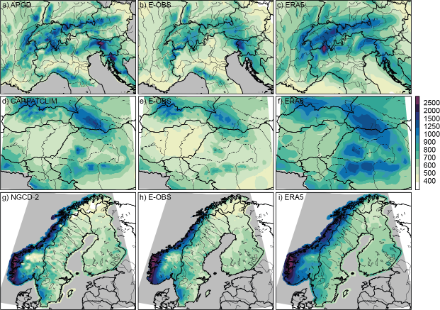Service Navigation
Search
C3Surf (C3S_311a_Lot4) in short
The C3Surf project is part of Copernicus Climate Change (C3S), which aims at providing high-quality information about climate change to support adaptation and mitigation policies with state-of-the-art climate data and tools. In this context, C3Surf provides climate monitoring products for Europe, based on ground-based observation networks. The core of the project builds on the European Climate Assessment and Dataset (ECA&D) and E-OBS daily dataset, which has become a reference for a larger user community in the last years. In the framework of C3Surf, ECA&D and E-OBS developed an operational system that delivers regularly updated gridded products based on European in-situ data for several climate variables. In addition, two regional grids covering the Alps and Fennoscandia are produced with higher resolution and extending over a longer period. The regional grids and E-Obs are compared in order to inform users about the strengths and limitations of the developed datasets.
Project leader is KNMI (Royal Netherlands Meteorological Institute). Further participants are EUMETNET (Conference of the National Meteorological Service in Europe), ZAMG (Austrian weather and geophysics service), DWD (German weather service), MET Norway (Meteorological service of Norway), OMSZ (Hungarian Meteorological Service), GCRI (Global Change Research Institute of the Czech Academy of Sciences) and UEA (University of East Anglia, Climatic Research Unit.
The next two sections describe the main contributions of MeteoSwiss in C3Surf.
MeteoSwiss contribution – LAPrec, a long-term time-consistent precipitation dataset
LAPrec (short for Long-term Alpine Precipitation reconstruction) is developed in collaboration with ZAMG, the Austrian weather and geophysics service. The new precipitation grid dataset extends back till 1871 and was specifically constructed to satisfy high standards in climate consistency. The dataset has a monthly resolution, covers the mountain range of the European Alps with territory from eight countries and is updated approximately every two years.
Unlike traditional approaches in spatial climatology, LAPrec builds on a statistical reconstruction (e.g. Isotta et al., 2019 and references therein) that integrates information from two data sources. The first, a set of high-quality station series, taken from the HISTALP station data archive (initiative of Alpine weather services, led by ZAMG, e.g. Auer et al. 2007), extends over the full period of interest, continuously without gaps. It informs about the temporal variation over the long term. The second, a high-resolution spatial analysis, the Alpine Precipitation Grid Dataset (APGD, Isotta et al. 2014), developed at MeteoSwiss, covers a few recent decades only but builds on data from thousands of rain-gauges. This component enriches the final result with spatial detail that is not resolved by the long-term stations alone. The approach explicitly avoids artefacts from variations in station density and it resolves major mesoscale patterns despite limited station coverage. Figure 1 depicts examples of monthly sums in June 1876, October 1907 and June 1910, when heavy precipitation events occurred in the Alpine region.
LAPrec is available here and soon in the Climate Data Store (CDS).

MeteoSwiss contribution – Comparison of climate datasets
Work package 4.2 (led by MeteoSwiss) in C3Surf aims at evaluating the E-OBS dataset, which has been produced in the framework of ECA&D, and subsequently updated in the framework of this C3SURF project. Given that the new global reanalysis from ECWMF, ERA5, was simultaneously released and thanks to a similar grid resolution it is also examined. In order to evaluate them, both datasets are being compared to regional high-resolution grid datasets from three European regions (Alps, Carpathians and Fennoscandia). Not only are these mountainous regions interesting from a climatological perspective, but there are also high-quality observational datasets available covering these regions. Thanks to including the densest possible station network and locally adjusted methods, they act as a reference in this evaluation. In the Alpine region, only precipitation was examined (with the reference being the Alpine Precipitation Grid Dataset (APGD)), whereas in the Carpathian region (CARPATCLIM) and in Fennoscandia (Norwegian Gridded Climate Datasets (NGCD)) both, precipitation and temperature, were investigated.
The results of the evaluation include the calculation of climate indices (e.g mean annual precipitation, see Figure 2), correspondence measures and an uncertainty evaluation. Based on these results the potential, as well as the limitations of E-OBS and ERA5 were determined. The most dominant finding for the precipitation analysis is that E-OBS strongly depends on the data availability in a certain area. While E-OBS is able to show realistic meso-beta scale precipitation patterns over Germany, Slovenia, Slovakia and over most of Fennoscandia, it performs worse especially over Romania, Ukraine, Croatia, Northern Italy, parts of France, Switzerland and Austria. Overall, this manifests in an underestimation of precipitation sums. ERA5, on the other hand, generally tends to overestimate precipitation, but it realistically resolves most large-scale precipitation patterns. Additionally, both ensemble datasets, E-OBS-Ens and ERA5-Ens underestimate the uncertainty compared to APGD-Ens. Nevertheless, both datasets have significantly improved compared to their older versions (older E-OBS and ERA-interim).
Regarding the temperature analysis in Fennoscandia and the Carpathians, E-OBS shows larger deviations in complex topography of Fennoscandia due to the absence of locally adapted methods, but it generally performs well in the Carpathians. Considering ERA5, most notably the Diurnal Temperature Range (Tmax – Tmin) is underestimated due to smoother temperature fields.

References
Auer, I., Böhm, R., Jurkovic, A., Lipa, W., Orlik, A., Potzmann, R., … Nieplova, E. (2007). HISTALP - historical instrumental climatological surface time series of the Greater Alpine Region. Int. J. Climatol., 27 (July 2006), 17–46. http://doi.org/10.1002/joc.1377
Isotta, F. A. and co-authors. 2014. The climate of daily precipitation in the Alps: development and analysis of a high‐resolution grid dataset from pan‐Alpine rain‐gauge data. Int. J. Climatol., 34(5), 1657-1675.
Isotta, F. A., Begert, M., & Frei, C. (2019). Long‐Term Consistent Monthly Temperature and Precipitation Grid Data Sets for Switzerland Over the Past 150 Years Journal of Geophysical Research : Atmospheres. J. Geophys. Res. Atmos., 123, 1–17. http://doi.org/10.1029/2018JD029910